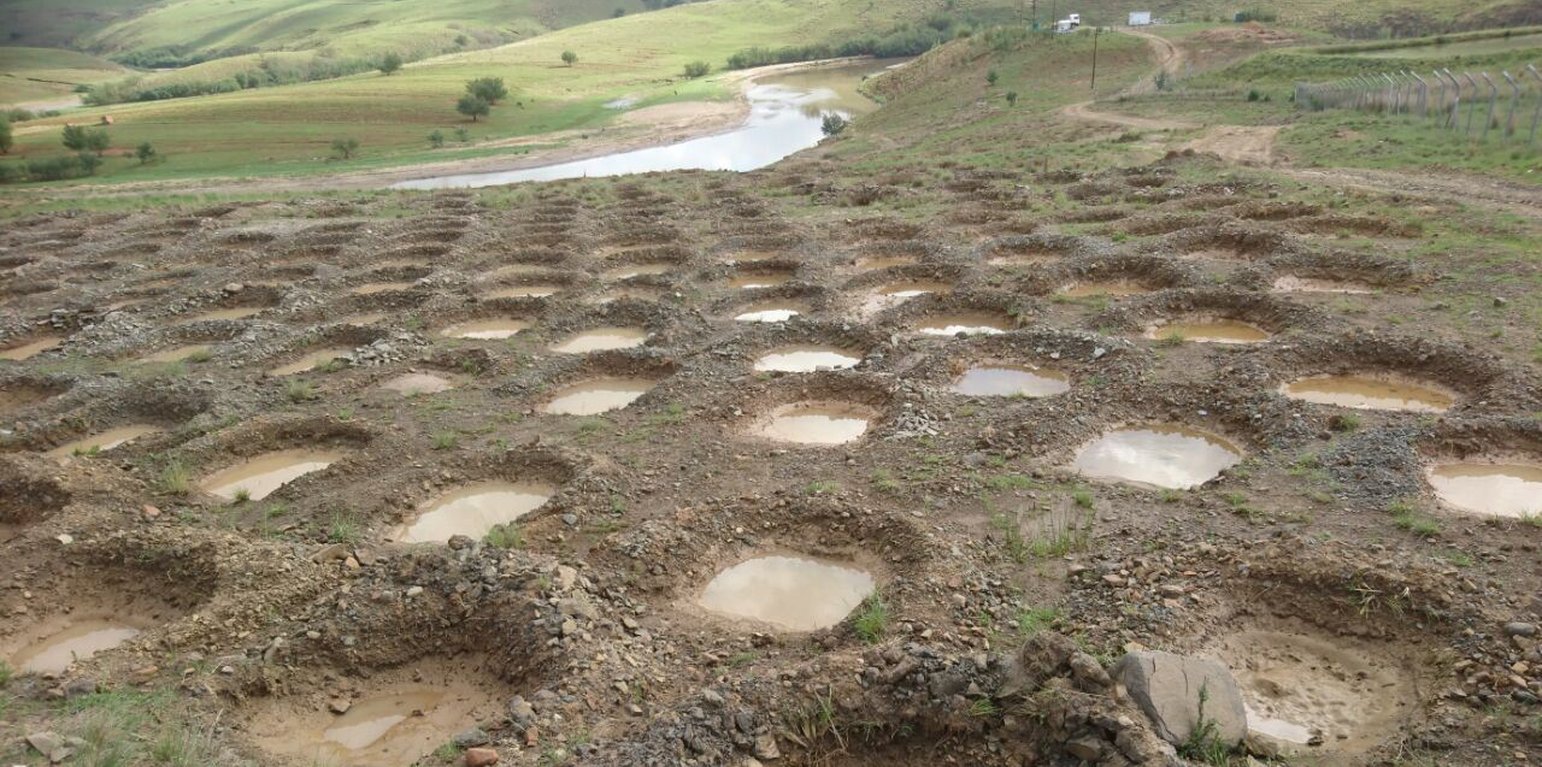



This project on pitting was implemented on the banks of the Mount Fletcher dam in the Eastern Cape of South Africa. The rehabilitation was funded by the Department of Environmental Affairs as part of the “Working on Ecosystems” programme. The programme also focuses on creating jobs and improving skill levels within local communities. The average annual rainfall in the area is 600 to 800 mm and occurs mainly in summer as thunderstorms. Severe sheet and rill erosion occur in the dam’s catchment. Combined with overgrazing and veld fires on the highly erodible soils, the catchment is severely degraded. Due to the degradation, high loads of sediment have resulted in severe siltation of the Mount Fletcher dam. The pitting technology can help. It is suitable for any low gradient, degraded, landscape as long as duplex soils are not present - due to piping on these soils. The main purpose of pitting is to enhance infiltration of runoff water by capturing, and ponding, it on capped/crusted bare soils. Simultaneously soil loss, due to sheet and rill erosion, is reduced. Secondary benefits of ponding runoff include trapping of sediment and subsequent improvement of vegetation cover. Pitting is combined with brush packing (laying cut bush on the soil’s surface) or mulching, and the construction of silt fences (low barriers across the slope) to further improve sediment trapping. This technology commences with the digging of small pits (70 cm surface diameter and 30 cm deep ) by hand or mechanical implements. The excavated soil is piled up to form a ridge on the down-slope. Pits are placed 2 meters apart in rows 1 meter apart. Re-seeding in pits with commercially available grass seed mixes can be used to enhance vegetation cover. Brush packing over the ponds with local woody (preferably thorny branches) material is recommended (if available locally) to provide protection against grazing and to create a micro-climate for vegetation growth. In between and above the pits silt fences or fiber rolls (can be used to slow water runoff (placed 10 m apart, across the slope).
Silt fences and fiber rolls are temporary sediment control devices used on rehabilitation sites to reduce sediment movement downhill. A typical fence consists of a piece of synthetic filter fabric (also called a geotextile) stretched between a series of wooden or metal fence stakes along a horizontal contour level. A fiber roll is made of wood fiber, straw, coconut fiber or similar material formed into a tubular roll also fixed by wooden or metal stakes.
Maintenance of the structures will include the creation of more pits and repair of silt fences and/or fiber rolls where needed. Further brush packing might be required after 6 months.
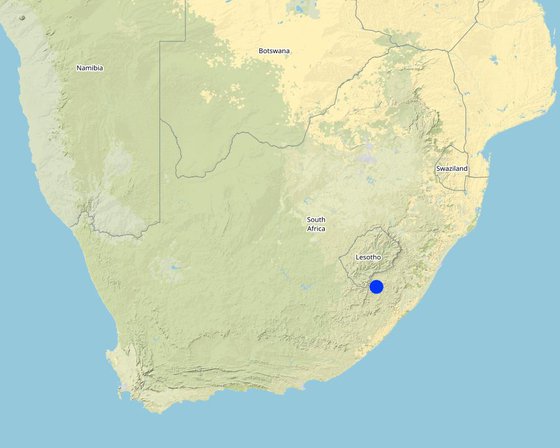
Location: Near the town of Mount Fletcher on the banks of the Mount Fletcher dam, Eastern Cape, South Africa
No. of Technology sites analysed: 10-100 sites
Spread of the Technology: evenly spread over an area (approx. 0.1-1 km2)
In a permanently protected area?:
Date of implementation: 2016
Type of introduction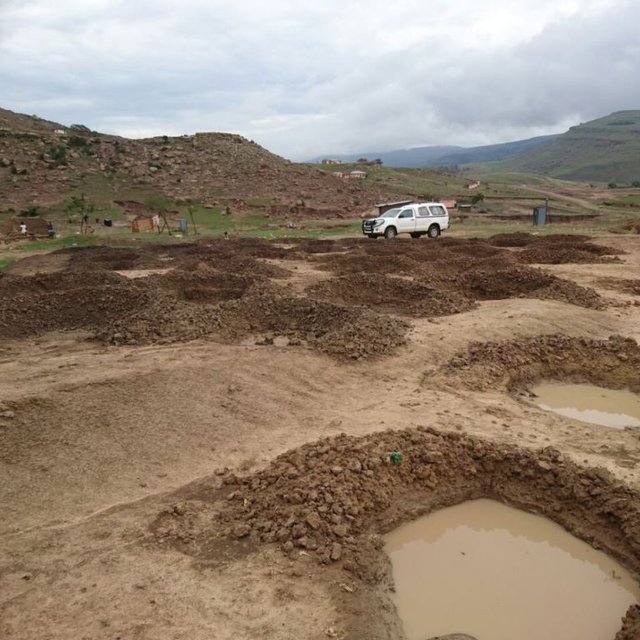
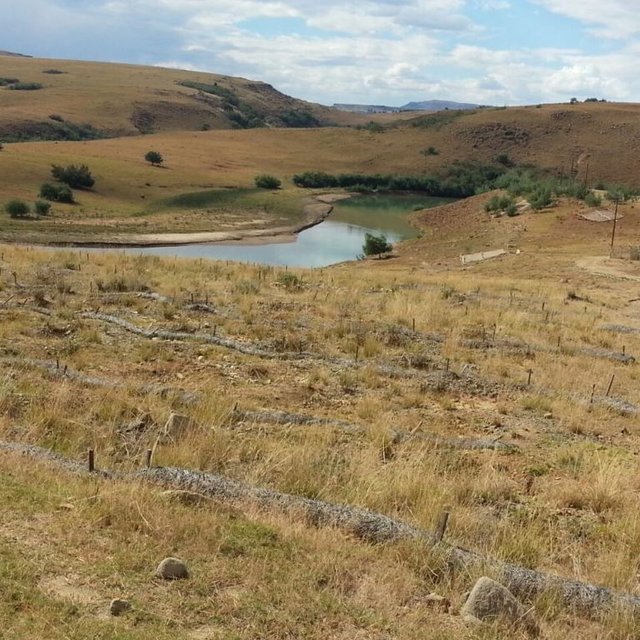






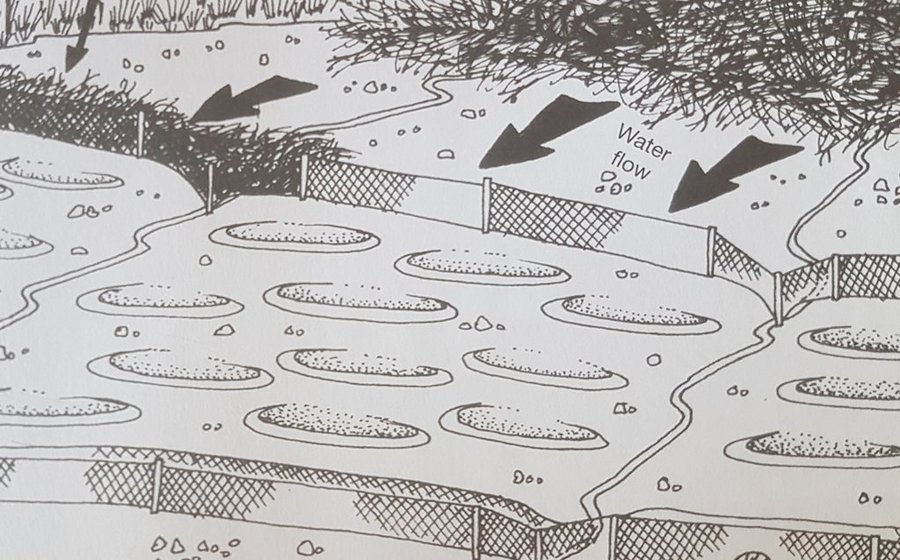
| Specify input | Unit | Quantity | Costs per Unit (Rand) | Total costs per input (Rand) | % of costs borne by land users |
| Labour | |||||
| Unskilled labour (including transport) | per day | 160.0 | 240.0 | 38400.0 | |
| Equipment | |||||
| Picks, spades, hand compactor, pliers, hopper, bow saws, hammer, wheel barrow (renting the equipment) | per day | 14.0 | 20.0 | 280.0 | |
| Plant material | |||||
| Grass seed | kilogram | 2.0 | 75.0 | 150.0 | |
| Construction material | |||||
| Silt fences or fibre rolls | per meter | 2000.0 | 15.0 | 30000.0 | |
| 1.0 | |||||
| Total costs for establishment of the Technology | 68'830.0 | ||||
| Total costs for establishment of the Technology in USD | 5'735.83 | ||||
| Specify input | Unit | Quantity | Costs per Unit (Rand) | Total costs per input (Rand) | % of costs borne by land users |
| Labour | |||||
| Unskilled labour | per day | 6.0 | 240.0 | 1440.0 | |
| Equipment | |||||
| Picks, spades, hand compactor, pliers, hopper, bow saws, hammer, wheel barrow (renting the equipment) | per day | 6.0 | 20.0 | 120.0 | |
| Plant material | |||||
| Grass seed | kilogram | 0.5 | 75.0 | 37.5 | |
| Construction material | |||||
| Silt fences | per meter | 200.0 | 15.0 | 3000.0 | |
| Total costs for maintenance of the Technology | 4'597.5 | ||||
| Total costs for maintenance of the Technology in USD | 383.13 | ||||
Initially, animals are not grazed on restored areas to allow vegetation recovery – but the long term impacts should be positive.
Brush packing is used to prevent animals from grazing on rehabilitated areas.
Infiltration improves - less runoff
Less sedimentation from runoff.
Infiltration improves - less runoff
Over the long-term farm income will increase - improved rangelands.
Jobs are created for community members.
Skill levels increased for some community members.
Household income increased for some community members.
Less sedimentation from runoff.
Improved species composition due to seeding in pits.
Less runoff
More biomass to burn (including fencing and fibre rolls)
Improved micro-climate due to brush packing.
Impact only slightly positive due to the extent of the erosion problem in the catchment - more pitting necessary to have a larger impact on the Mount Fletcher dam.
Same as above.